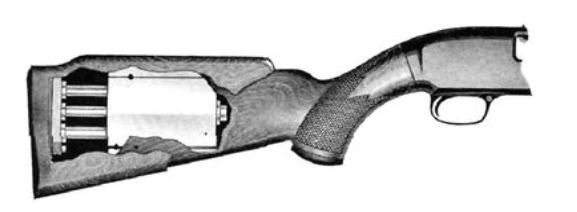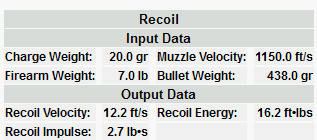


The Shotgun and the Springy Stock Thing

In
1963, Sports Illustrated covered the Hydro-Coil stock, saying “Relief
is now in sight and within range of most shooters' pocketbooks. Ralph
O. Hoge, 54, an inveterate Hollywood inventor and an occasional motion
picture director, has designed and patented Hydro-Coil, an ingenious recoil-absorbing
device that actually cuts recoil by as much as 85% and reduces the powerful
kick of a shotgun or rifle to a nudge.” SI further added, “For
the occasional shooter, or the competitive shooter who fires steadily
for hours, Hydro-Coil should be a welcome relief. It will appeal immediately
to trap and skeet shooters, particularly youngsters, women and elderly
people who suffer most from the shock of recoil. It probably will be accepted
even by stubborn shooters who silently endure recoil on the range and
then proudly wear their black-and-blue marks afterwards.” This
was over fifty years ago. It has been revisited regularly ever since.
More recently, premium after-market solutions include the SoftTouch systems,
the G-Squared Shockmaster, Ken Rucker's Bump-Buster Hydraulic Recoil Reduction
System, and the essentially infinitely adjustable PFS (Precision Fit Stocks).
Felt recoil is the perpetual problem being addressed. The biggest single problem is addressed by Stock Fitter's Bible: Second Edition, by Rollin Oswald. It is one of the best investments any shotgun enthusiast can make to understand what proper gun fit is all about.
Other factory attempts include the Beretta “Kick-Off” and when it comes to springy stock things, we have not only various recoil-pad versions, but there is also the Mathews Harmonic Damper idea, applied to shotguns by Mossberg. We also have the patented Benelli ComfortTech stock and now, the “Progressive Comfort System” introduced in the Benelli Ethos.
THE
PROBLEMS AND CONSIDERATIONS
There are several considerations for all of these approaches. There is
cost, aesthetic value, weight, durability, and how it affects a shotgun's
balance and feel. There is also adjustability.
The combination spring / hydraulic system is in constant, daily use by
most everyone that drives a car or rides a motorcycle. Individual conditions
of use change, of course, and everyone that has cranked up the shocks
in their motorcycle, or changed the air pressure in their tires to firm
up or soften the ride and handling is familiar with this.
Trap shooters, for example, are often using the same loads constantly. In a spring over hydraulic system such as the SoftTouch, to cite one example, you can firm up or soften the system to suit the gun weight, the load, and your personal preference.
In factory-supplied systems, the wiggly, wobbly pogo stick feel is not user-adjustable, so what you have is essentially it. It may be something you like with light loads, it may be a disaster with heavy loads, but that is largely user preference.
What is going to happen with any recoil pad or stock system, is there will be gun movement: the tolerance for gun movement versus the “solid feel” is again, up to the individual. If the stock collapse happens in front of the cheekweld, it is just gun movement. If it happens at the butt, the buttstock of the gun must slide across your face. How much face-sliding you can stand, is up to you.
The Beretta “Kick-Off” idea is one of the worst, at least for me. I have an aversion to shooting a pogo stick, the face-sliding is obnoxious, and too many of them break. Cole Gunsmithing gets in a goodly number of broken units. As far as I'm concerned, I don't care if they break or not, for I'm not going to put up with the feel.
A couple of the most comfortable shooting shotguns out there are the Fabarm XLR5 Velocity, a competition target gun, and the Remington Versa Max, a heavy-duty waterfowler. Both are heavy, substantial guns, both are gas-operated, and a substantial gas-operated gun is as close to a sure-fire ticket to soft-shooting as there is, assuming good stock fit.
WHAT ARE SOME ANSWERS?
None of the available “solutions” are complete solutions. If the springy stock thing totally eliminated unwanted felt recoil, then none of them would use rubber recoil pads. Of current factory-supplied and after-market devices, take a look . . . virtually all of them have recoil pads made of mysterious medical polymers, gels, sub-miniature micro cores, vents, and so forth. All of these rubberoid marvels would be worthless if felt recoil was eliminated by the stock system itself. The percentage claims of recoil reduction do not bear close scrutiny.


The recoil of a 1300 fps 1-3/4 oz. payload is about 56.2 ft./lbs (directly above), compared to the 16.2 ft./lbs. of a 1 oz. 1150 fps payload (upper image), both from a seven pound firearm. The 1 oz. (438 grain) shell has less than 29% of the recoil of the 1-3/4 oz. shell. If you want a 71% recoil reduction from your long range pheasant load, a shell change alone can accomplish that: no recoil pad required, much less a springy stock thing. Percentages tell you nothing, specifically, about shooting comfort.
The only thing that you can do to your shotgun with no compromise, no downside, and only advantage is to improve the stock fit. That's a close to a free lunch as it gets. The rest of the approaches are constrained by the envelope dimensions of the stock itself, your tolerance for stock noise, change in balance of the gun, weight addition to the gun, durability of the system, and your own tolerance for stock movement.
The "better" answer cannot be the same for a target shooter that shoots the same load again and again, versus the folks that might want to break some clay, but are also going to hunt pigeons, pheasants, ducks, geese, and turkey . . . or a personal chef's mix of at least some clay shooting and some hunting, with the same gun.
BETTER COMBINATIONS
The harshest-shooting guns are fixed breech guns (O/U, SxS,) and shotguns that fire as fixed-breech guns (slide-action, inertia). Gas autoloaders are the most comfortable, as a class. Stock fit is equally important to all shotguns, regardless of action type. The long recoil gun, as embodied by the J.M.B. Automatic-Five, shoots cleaner than any gas autoloader, yet has less recoil than any fixed breech gun, pump, or inertia action. The sliding stock is not a factor in an A-5, for the barrel itself does the sliding, pushing against the huge forearm spring, with the friction array controlling the braking for variations in loads.
In a fixed breech gun, for premounted clay games, both the "G-Squared Shockmaster" and "SoftTouch" systems with the comb that moves in unison with the butt are considered among the best. Both take away the face-rake / face-scrape issues of collapsing butt springy stock things.
SPECIFIC EXAMPLES
Twenty Gauge 7/8 oz. AA Loads
In side-by-side testing of over two dozen autoloaders, the softest shooting shotgun is one that is no longer made: the older, 7 lb. or so, Browning Gold 20 Gauge.
Twenty Gauge 1-1/2 oz. Federal Heavyweight
In side-by-side testing with over one dozen autoloaders, the softest shooting was another shotgun no longer made: the Browning A-5 Mag 20.
12 Gauge Field Guns
Testing across the spectrum with three current 7 lb. category models, http://www.randywakeman.com/A400vsBrowningMaxusBenelliVinci.htm showed the Maxus to be the softest shooting overall. With higher intensity loads, the Vinci pulled very close to the Maxus, showing that the ComforTech stock is extremely effective. Yet, the Remington Versa Max, gas-operated, weighing over 8 lbs., and with a generous recoil pad, is the softest-shooting hunting autoloader in current production. The softest-shooting target gun is the heavy, gas-operated, Fabarm XLR5.
Benelli ComforTech
Whether 12 or 20 gauge, the Benelli ComforTech stock is softer-shooting than similarly weighted fixed breech guns. It works better as shell intensity increases. It makes recoil a non-issue when hunting pheasants with a 6 lb. gun, with 1-5/16 oz. lead loads, as shown below.
Many things do not have any noticeable effect on recoil: forcing cone work and over-bored barrels have been shown not to work. With porting, in a shotgun, the effect is not significant. Only the increased loudness is.
Contingent on category and shell intensity, the softest-shooting shotguns may be an obsolete Browning, a Benelli, a Weatherby, a Remington, or a Fabarm. No brand favorites here, to make an understatement. For the "Springy Stock Thing" to be of benefit, you have to have a level of bothersome recoil in the first place. Neither the Remington Versa Max or the Fabarm XLR5 Velocity are good candidates for springy stock things.
While the latest Benelli Comfortech stocks are not all that springy, they do clearly work, don't rattle, rust, break, or go out of adjustment, and they don't feel like you are shooting a pogo stick. They do not rise to the level of heavy gas-operated autoloaders in overall shooting comfort levels, but they get close to gas guns of the same weight, particularly with heavier loads.
The new Benelli Ethos' "Progressive Comfort System" shows promise, as it is essentially a plastic wafer array that allows movement, but gives increased resistance to movement as the travel increases. The stock does slide across the face, but that is addressed by a polymer comb insert that makes it less invasive. In shooting the Ethos, I noticed that if you hold the pistol grip of the buttstock loosely, it will pull backwards out of your hand. While not quite as effective as the heavy gas gun approach overall, it importantly adds no weight to the buttstock, needs no lubrication, makes no noise, and does not seem to be greatly affected by cold temperature. By allowing rearward movement, it helps insure reliability of the inertia action that needs rearward movement to function in the first place.
Finally
There are compromises inherent in all springy stock things and recoil reducing approaches. For the trap shooter, weight of the system isn't the issue it would be in a spritely, lively field gun. No one manufacturer has a solution that appeals to everyone. The shotgun brands already mentioned here, Browning, Benelli, Fabarm, Weatherby, and Remington might all be the "better choice" contigent on the application and what you are willing to invest.
I'm not especially recoil-sensitive, but I don't have any neck, arthritis, or back problems, either. Some folks do, of course, and if not for attention to gun fit and some of the springy stock things, they would no longer be shooting or hunting. I normally don't pay much attention to recoil, but the effects are cumulative and noticeable. Even with 1180 fps, 1 oz. loads, the light (6.5 lb.) gas-operated Weatherby SA-08 was softer-shooting than the Girsan and the new Browning A5. While discomfort wasn't the issue, with that shell, shot recovery time was noticeably less with the Weatherby SA-08 than the other two.
Copyright 2014 by Randy Wakeman. All Rights Reserved.




